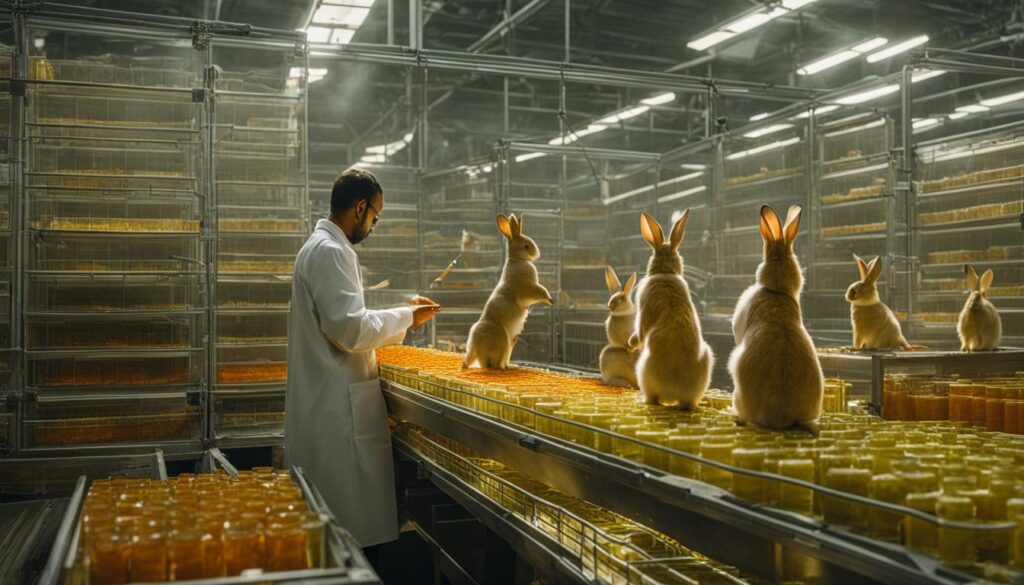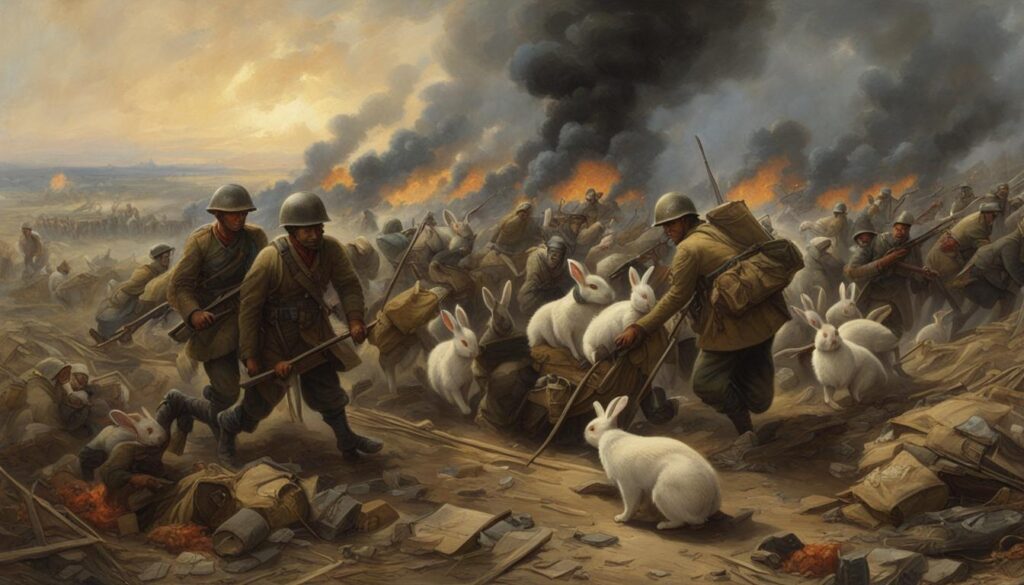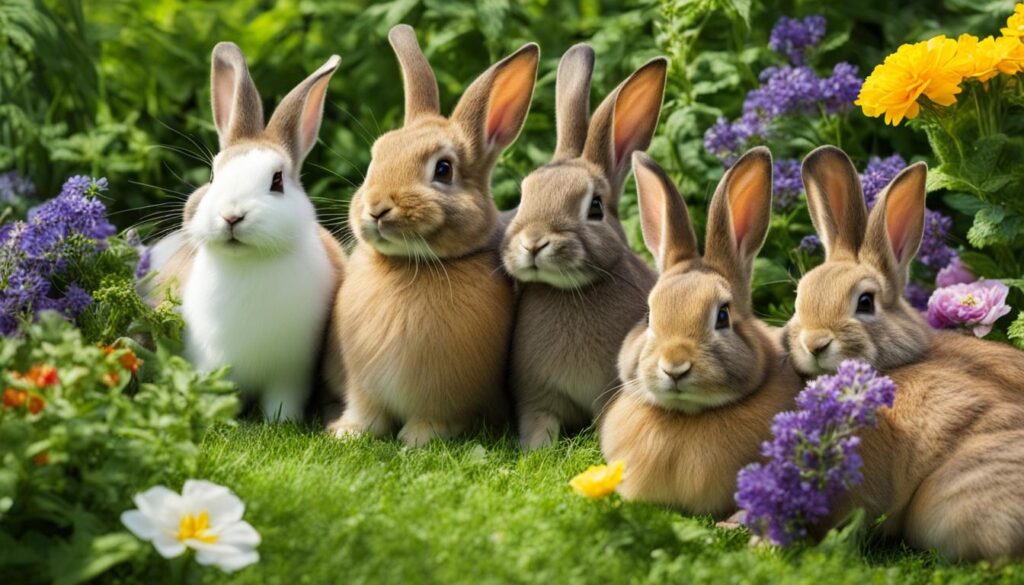Rabbits in Warfare: How They Supported Humans During World Wars
Did you know that rabbits played a significant role in supporting humans during the World Wars? These small and unsuspecting creatures made a historical impact in various ways, from contributing to the war effort to being cherished as pets. Let’s delve into the historical significance of rabbits in war and their involvement in rabbit breeding.
One notable project, known as Project Angora, was initiated by Heinrich Himmler, the head of the SS, during World War II. This program aimed to breed angora rabbits in concentration camps to produce wool for German military uniforms. The success of this program resulted in the breeding of nearly 65,000 rabbits and the production of over 10,000 pounds of wool. These rabbits were housed in notorious camps such as Auschwitz, Dachau, and Mauthausen, surviving in stark contrast to the cruelty inflicted upon human prisoners. The existence of Project Angora remained hidden until a photo album depicting the well-cared-for rabbits and the luxurious conditions they were kept in was discovered after the war.
Key Takeaways:
- Rabbits played a significant role in supporting humans during the World Wars.
- Project Angora involved breeding rabbits in concentration camps for their wool.
- These rabbits were housed in camps such as Auschwitz, Dachau, and Mauthausen.
- Project Angora remained hidden until a photo album was discovered after the war.
- The rabbits’ wool was intended for German military uniforms.
The Role of Rabbits in Penicillin Production During World War II
During World War II, rabbits played a crucial role in the production of penicillin. This highly sought-after wonder drug required large-scale production and rigorous testing to ensure its safety and efficacy. One of the key methods utilized in testing penicillin was the rabbit pyrogen test, which was pioneered by Florence Seibert in the 1920s.
The rabbit pyrogen test became the preferred method for assessing the safety of penicillin during the 1940s. In this test, technicians would inject penicillin into a vein in a rabbit’s ear and closely monitor its temperature for any signs of fever. If the rabbit exhibited elevated body temperature, it indicated the presence of contaminants or impurities in the penicillin batch, rendering it unsafe for human use.
This test allowed researchers to quickly and efficiently test large quantities of penicillin, ensuring that only the highest quality and safest batches were produced for the soldiers and civilians in need. Although alternative testing methods have been developed in modern times, the rabbit pyrogen test played a vital role in the early stages of penicillin production, contributing to its widespread availability and aiding the successful treatment of infectious diseases during the war.
Florence Seibert: Pioneering the Rabbit Pyrogen Test
“The rabbit pyrogen test provided a reliable and efficient means of assessing the safety of penicillin. It allowed us to identify and eliminate any potential risks associated with the drug, ensuring that it could be administered to our troops with confidence and without fear of adverse reactions. The rabbits played a crucial role in this process, and their contribution to the war effort cannot be overstated.”
– Florence Seibert, pioneering biochemist
| Advantages of the Rabbit Pyrogen Test | Limitations of the Rabbit Pyrogen Test |
|---|---|
|
|
Despite its limitations, the rabbit pyrogen test played a crucial role in the advancement of penicillin production and contributed to the successful treatment of infectious diseases during World War II. It exemplifies the historical significance of rabbits in war efforts, showcasing their ability to aid humans in times of need through their unique biological characteristics.

The Survival of the “Rabbits” of Ravensbrück
In Ravensbrück concentration camp, a group of Polish women known as the “rabbits” faced a grim fate. Due to their involvement in underground organizations, they were initially sentenced to death. However, before their execution, they became subjects of experimental operations, with their legs mutilated and injected with diseases. Despite the brutality they endured, most of the rabbits survived the experiments.
As the Red Army approached Ravensbrück, the rabbits defied the camp administration’s orders to be transported, as they knew it would likely lead to their deaths. With the support of other prisoners and the assistance of Red Army women, the rabbits managed to evade capture and survive until the liberation of the camp. Their resilience and defiance inspired support from within the camp, defying the Nazis’ intentions.
Witnessing the survival of these “rabbits” serves as a testament to their strength and determination in the face of unimaginable cruelty. Their story sheds light on the untold sacrifices and resistance exhibited by individuals during times of war.

“Despite the brutality they endured, most of the rabbits survived the experiments.”
Rabbit Breeding and Pet Rabbits: A Historical Perspective
Rabbit breeding and the practice of keeping pet rabbits have a rich history that provides insight into cultural and societal values. In the mid-1930s, rabbit breeding gained popularity in Germany, leading to the formation of the Reich Specialized Group of Rabbit Breeders. During this time, the angora rabbit, introduced from the United Kingdom in the 17th century, became particularly favored for its high-quality fur.

German rabbit breeders took meticulous care in breeding these rabbits, ensuring the production of superior fur. Interestingly, the Nazis, while promoting animal welfare, even banned vivisection – the dissection of live animals for experimentation. At the Buchenwald concentration camp, Commandant Karl Koch maintained a zoo next to the camp, further highlighting the cultural significance of animals during that time.
The Reich Specialized Group of Rabbit Breeders
| Year | Event |
|---|---|
| 1930 | Reich Specialized Group of Rabbit Breeders established |
| 1935 | Angora rabbits gain popularity in Germany |
| 1940 | Animal welfare promoted, vivisection banned by Nazis |
| 1944 | Zoo next to Buchenwald concentration camp maintained |
Rabbit breeding and the keeping of pet rabbits provide us with a historical perspective on the cultural values and practices of the time. These activities not only served practical purposes but also symbolized a connection with nature and the domestication of animals. Understanding the historical significance of rabbit breeding and pet rabbits allows us to appreciate the societal contexts in which these practices emerged.
Conclusion
The historical significance of rabbits in war is undeniable. Throughout various conflicts, rabbits have played a crucial role in supporting humans. From their involvement in projects like Project Angora during World War II, where they were bred to produce wool for German military uniforms, to their assistance in the production of penicillin, rabbits have proven their worth.
One striking example of their resilience and defiance can be seen in the survival of the “rabbits” of Ravensbrück concentration camp. Despite facing unimaginable cruelty and experimental operations, these women managed to evade capture and survive until the camp’s liberation. Their courage is a testament to the strength of the human spirit.
Additionally, the history of rabbit breeding and the practice of keeping pet rabbits offer insights into cultural practices and societal values. In Germany, rabbit breeding became popular in the 1930s, with meticulous care given to breeding angora rabbits for their high-quality fur. The Nazis even banned vivisection and maintained a zoo next to Buchenwald concentration camp, demonstrating an apparent concern for animal welfare.
As we reflect on the impact of rabbits in war, it is clear that they have left an indelible mark on history. Their historical significance and the role they have played in human history cannot be ignored. Whether as companions, sources of resources, or symbols of resilience, rabbits continue to hold a special place in our collective memory.
FAQ
How did rabbits support humans during the World Wars?
Rabbits played a significant role in various ways during the World Wars. They were utilized in projects such as Project Angora, which aimed to breed angora rabbits in concentration camps to produce wool for German military uniforms. Additionally, rabbits were involved in the production of penicillin, where the rabbit pyrogen test was used to test the safety of the drug. The “rabbits” of Ravensbrück also defied the Nazis and survived experimental operations.
What was Project Angora during World War II?
Project Angora was an initiative led by Heinrich Himmler, the head of the SS, during World War II. It involved breeding angora rabbits in concentration camps such as Auschwitz, Dachau, and Mauthausen to produce wool for German military uniforms. Nearly 65,000 rabbits were bred, resulting in over 10,000 pounds of wool. This project remained hidden until a photo album containing evidence was discovered after the war.
How were rabbits involved in penicillin production during World War II?
Rabbits played a crucial role in the production of penicillin during World War II. The rabbit pyrogen test, developed by Florence Seibert, was used to test the safety of large quantities of penicillin. Technicians would inject penicillin into a vein in a rabbit’s ear and monitor its temperature for signs of fever. This test allowed researchers to ensure the safety of penicillin before it was used on humans.
What happened to the “rabbits” of Ravensbrück?
The “rabbits” of Ravensbrück were a group of Polish women who faced a grim fate. Originally sentenced to death due to their involvement in underground organizations, they were chosen for experimental operations instead. Their legs were mutilated and injected with diseases. Despite the brutality, most of the rabbits survived the experiments and defied the camp administration’s orders to be transported when the Red Army approached. They managed to evade capture and survive until the liberation of the camp.
What is the history of rabbit breeding and pet rabbits?
Rabbit breeding became popular in Germany in the mid-1930s, with a Reich Specialized Group of Rabbit Breeders formed. The angora rabbit, introduced from the United Kingdom in the 17th century, was favored for its high-quality fur. The Nazis even banned vivisection and certain camp commandants, such as Karl Koch of Buchenwald, maintained zoos near the camps. The history of rabbit breeding and pet rabbits provides insights into cultural practices and societal values of the time.


